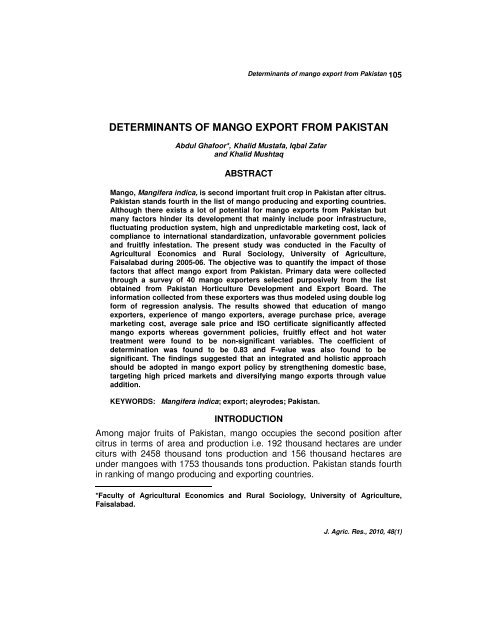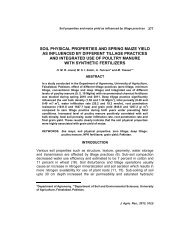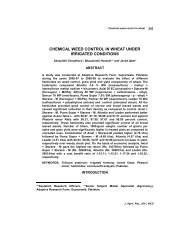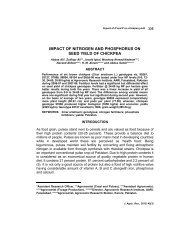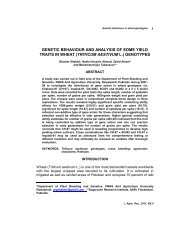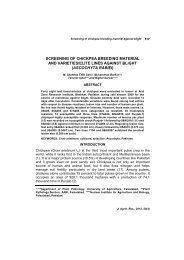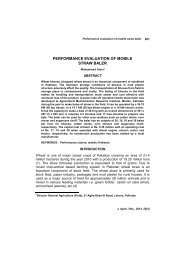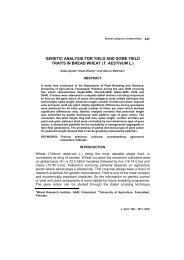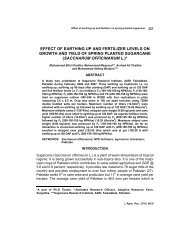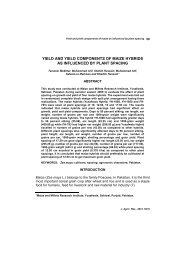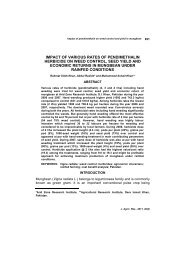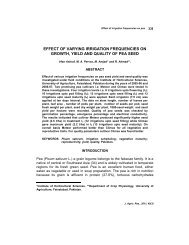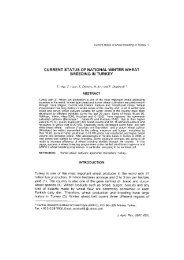Determinants of Mango Export from Pakistan Abdul Ghafoor, Khalid ...
Determinants of Mango Export from Pakistan Abdul Ghafoor, Khalid ...
Determinants of Mango Export from Pakistan Abdul Ghafoor, Khalid ...
Create successful ePaper yourself
Turn your PDF publications into a flip-book with our unique Google optimized e-Paper software.
<strong>Determinants</strong> <strong>of</strong> mango export <strong>from</strong> <strong>Pakistan</strong> 105DETERMINANTS OF MANGO EXPORT FROM PAKISTAN<strong>Abdul</strong> <strong>Ghafoor</strong>*, <strong>Khalid</strong> Mustafa, Iqbal Zafarand <strong>Khalid</strong> MushtaqABSTRACT<strong>Mango</strong>, Mangifera indica, is second important fruit crop in <strong>Pakistan</strong> after citrus.<strong>Pakistan</strong> stands fourth in the list <strong>of</strong> mango producing and exporting countries.Although there exists a lot <strong>of</strong> potential for mango exports <strong>from</strong> <strong>Pakistan</strong> butmany factors hinder its development that mainly include poor infrastructure,fluctuating production system, high and unpredictable marketing cost, lack <strong>of</strong>compliance to international standardization, unfavorable government policiesand fruitfly infestation. The present study was conducted in the Faculty <strong>of</strong>Agricultural Economics and Rural Sociology, University <strong>of</strong> Agriculture,Faisalabad during 2005-06. The objective was to quantify the impact <strong>of</strong> thosefactors that affect mango export <strong>from</strong> <strong>Pakistan</strong>. Primary data were collectedthrough a survey <strong>of</strong> 40 mango exporters selected purposively <strong>from</strong> the listobtained <strong>from</strong> <strong>Pakistan</strong> Horticulture Development and <strong>Export</strong> Board. Theinformation collected <strong>from</strong> these exporters was thus modeled using double logform <strong>of</strong> regression analysis. The results showed that education <strong>of</strong> mangoexporters, experience <strong>of</strong> mango exporters, average purchase price, averagemarketing cost, average sale price and ISO certificate significantly affectedmango exports whereas government policies, fruitfly effect and hot watertreatment were found to be non-significant variables. The coefficient <strong>of</strong>determination was found to be 0.83 and F-value was also found to besignificant. The findings suggested that an integrated and holistic approachshould be adopted in mango export policy by strengthening domestic base,targeting high priced markets and diversifying mango exports through valueaddition.KEYWORDS: Mangifera indica; export; aleyrodes; <strong>Pakistan</strong>.INTRODUCTIONAmong major fruits <strong>of</strong> <strong>Pakistan</strong>, mango occupies the second position aftercitrus in terms <strong>of</strong> area and production i.e. 192 thousand hectares are underciturs with 2458 thousand tons production and 156 thousand hectares areunder mangoes with 1753 thousands tons production. <strong>Pakistan</strong> stands fourthin ranking <strong>of</strong> mango producing and exporting countries.*Faculty <strong>of</strong> Agricultural Economics and Rural Sociology, University <strong>of</strong> Agriculture,Faisalabad.J. Agric. Res., 2010, 48(1)
106 A. <strong>Ghafoor</strong> et al.<strong>Mango</strong> is mainly produced in Punjab and Sindh. Punjab contributes 67percent whereas Sindh shares 32 percent to total production (3). Harvestingbegins in Sindh in late May and finishes in Punjb in late August. Sindhri is themajor variety grown in Sindh while in Punjab Chaunsa dominates. Othermajor varieties grown in Punjab and Sindh are Began Pali, Langra and AnwarRetaul. Both Chaunsa and Sindhri are considered as excellent varieties forindustry. Sindhri has better post harvest attributes in terms <strong>of</strong> taste anddemand for export markets (4).Major export markets <strong>of</strong> <strong>Pakistan</strong>i mango include Dubai, Saudi Arabia,Oman, United Kingdom, Kuwait, Bahrain, France and Germany, contributingabout 41, 16, 11, 10, 3, 2, 1 and 0.90 percent <strong>of</strong> total mango exports <strong>from</strong><strong>Pakistan</strong>, respectively. These markets collectively contribute 85 percent <strong>of</strong>total mango export <strong>from</strong> <strong>Pakistan</strong> (2). So Gulf and Saudi Arabia aretraditional export markets and consume major volume <strong>of</strong> <strong>Pakistan</strong>’s mangoexports whereas England is the major market in Europe. China and Iran arelikely to emerge as future prominent markets (4). Large number <strong>of</strong> <strong>Pakistan</strong>iimmigrants, increased availability <strong>of</strong> shipping facilities, old traditional relationswith importers and special likeliness <strong>of</strong> people <strong>of</strong> importing countries towards<strong>Pakistan</strong>i mangoes (in terms <strong>of</strong> taste, colour, aroma, size, etc.) are the majorcontributing factors for trading transactions with these countries.Although there is a lot <strong>of</strong> potential in exporting mango <strong>from</strong> <strong>Pakistan</strong> yet onlya nominal amount is being exported. <strong>Mango</strong> export system in <strong>Pakistan</strong> is notefficient and systematic to an extent that could utilize full potential <strong>of</strong> mangoeconomy. Most <strong>of</strong> the efforts to export mango are self centered and individualbased with very little utilization <strong>of</strong> centrally organized platforms. Theprogressive exporters having large financial sources, personal contacts withimporters, a better supply source, informative knowledge and better exportmanagement practices, are in a position to exploit the opportunities ininternational mango market but most exporters suffer due to poorly organizedmango export system. Majority <strong>of</strong> the established exporters having their setup in Karachi, purchase both <strong>from</strong> Punjab and Sindh and then prepare theproduce in their processing centers. They use their own brand name andpackaging material. In the absence <strong>of</strong> an established common platform,some <strong>of</strong> seasonal traders have also entered in this business. Dreaming <strong>of</strong>high pr<strong>of</strong>it in a short duration, they <strong>of</strong>ten use some unethical means in theirexport business, which give a bad name and reputation to <strong>Pakistan</strong>i exports.<strong>Pakistan</strong>i mangoes being cheap with average quality are dumped byexporters in the export markets such as UAE. Sales <strong>of</strong> <strong>Pakistan</strong>i fruit in manyJ. Agric. Res., 2010, 48(1)
<strong>Determinants</strong> <strong>of</strong> mango export <strong>from</strong> <strong>Pakistan</strong> 107export markets are targeted mainly to the local expatriates (<strong>Pakistan</strong>i/Indian)communities (9). Irrespective <strong>of</strong> all these factors <strong>Pakistan</strong>i mango exports areincreasing which show that demand for <strong>Pakistan</strong>i mango is increasing andthere exists a good market at international level. During past years, share <strong>of</strong>mango exports in total fruit exports <strong>from</strong> <strong>Pakistan</strong> has increased <strong>from</strong> 1.75percent in 1975-76 to 30.62 percent in 2004-05. <strong>Mango</strong> exports as a percent<strong>of</strong> total mango production is quite nominal but an increasing trend in thisregard has been noted in recent past years. The share <strong>of</strong> mango exports intotal mango production in <strong>Pakistan</strong> increased <strong>from</strong> 0.19 percent in 1975-76 to7.53 percent in 2004-05 (1).<strong>Mango</strong> is a perishable commodity, which needs speedy, effective and carefulhandling during export process. Cargo arrangements at exit points do notqualify these criteria. Long delays, rough handling and inappropriatebehaviour <strong>of</strong> staff make the export process quite cumbersome. Timeschedule is <strong>of</strong>ten disturbed due to limited space in cargo and airlines severelyaffecting the quality <strong>of</strong> export consignment making it difficult. Domesticallyover 90 percent <strong>of</strong> freight and passenger traffic moves by road. However, 50percent <strong>of</strong> <strong>Pakistan</strong>'s national highway network is in a poor condition,significantly adding to transportation costs and reducing exportcompetitiveness in the country (5).In case <strong>of</strong> mango export <strong>from</strong> <strong>Pakistan</strong>, fruitfly infestation issue has nowbeen a commonly understood by all stakeholders but still no serious actionhas been taken. Govternment <strong>of</strong> Japan donated vapour heat treatment plantthat has been confined only to the laboratory <strong>of</strong> Plant Protection Departmentand still is not available for commercial use. Existing facilities <strong>of</strong> hot watertreatment are also quite limited and not upto the standard. Hot watertreatment requires scientific handling and specifications which if not observedmay lead to undesirable results.Standardization <strong>of</strong> exporting firms is another critical factor, which affectexports particularly to those countries which demand it. Lack <strong>of</strong> compliance tothese standards is another factor responsible for weak performance <strong>of</strong><strong>Pakistan</strong>i mango exports.In view <strong>of</strong> current status and importance <strong>of</strong> mango in national economy <strong>of</strong><strong>Pakistan</strong>, the study in hand was designed to explore those factors whichdirectly or indirectly affect mango exports <strong>from</strong> <strong>Pakistan</strong>.J. Agric. Res., 2010, 48(1)
108 A. <strong>Ghafoor</strong> et al.MATERIALS AND METHODSThis study was conducted in the Faculty <strong>of</strong> Agricultural Economics and RuralSociology, University <strong>of</strong> Agriculture, Faisalabad during 2005-06. A samplingframe is a list <strong>of</strong> all sampling units available for selection at a given stage <strong>of</strong>sampling process (7). In this regard, list <strong>of</strong> mango exporters was obtained<strong>from</strong> <strong>Pakistan</strong> Horticultural Development and <strong>Export</strong> Board (PHDEB). The listconsisted <strong>of</strong> 100 mango exporters in <strong>Pakistan</strong>. During this processconsultations were made with the experts <strong>from</strong> PHDEB and only thosemango exporters were considered who were exporting to eight dominatingmarkets (Dubai, Saudi Arabia, Oman, United Kingdom, Kuwait, Bahrain,France and Germany) because these constitute 85 percent <strong>of</strong> the totalmango export <strong>from</strong> <strong>Pakistan</strong>. In addition to this, regularity, progressivenessand overall attitude <strong>of</strong> the exporters were the other elements, which wereconsidered during the short-listing <strong>of</strong> exporters. The short-listed 60 exporterswere the sampling frame for this study and then a total sample <strong>of</strong> 40exporters was selected randomly <strong>from</strong> given sampling frame.Primary data were collected through survey <strong>of</strong> selected mango exportersusing a pre-tested questionnaire containing both structured and unstructuredquestions. Personal interviews method was used to collect information <strong>from</strong>primary sources. Data <strong>from</strong> primary sources were collected for the exportseason <strong>of</strong> 2005-06 and then were converted into uniform units for analysis.Frequency distribution regarding important traits <strong>of</strong> mango exporters wascalculated using following formula.XF = ———— x 100 ……….. (1)NF = Frequency distributionX = The observed observationsN = The total observationsMajor focus <strong>of</strong> this study was to explore the effect <strong>of</strong> those variables, whichaffect mango exports <strong>from</strong> <strong>Pakistan</strong>. A regression model was estimated inthis context to delineate the impact <strong>of</strong> some micro variables on the export <strong>of</strong>mango <strong>from</strong> <strong>Pakistan</strong>. In the present research, dependent variable was thequantity <strong>of</strong> mango exports (tonnes) for each respective exporter for exportingyear 2005-06. Major independent variables considered for this exerciseincluded education <strong>of</strong> respective exporters (number <strong>of</strong> schooling years),pr<strong>of</strong>essional experience (years), average purchase prices <strong>of</strong> mango (Rs. perJ. Agric. Res., 2010, 48(1)
<strong>Determinants</strong> <strong>of</strong> mango export <strong>from</strong> <strong>Pakistan</strong> 109tonne), average marketing costs (Rs. per tonne) and average sale prices forexported mangoes (Rs. per tonne).In regression analysis it frequently happens that dependent variable is notonly affected by the variables which can readily be quantified on some welldefined scales but also by variables which are essentially qualitative in naturelike government economic policy. Since such variables usually indicate thepresence or absence <strong>of</strong> a quality or attribute, one method <strong>of</strong> quantifying suchattributes is by constructing artificial variable which takes on the values <strong>of</strong> 1and 0, 1 indicating the presence <strong>of</strong> that attribute and 0 indicating absence <strong>of</strong>that attribute. Such variables are known as dummy variables (10). In thepresent study, in addition to above-mentioned quantitative variables, certainqualitative variables were also used in the form <strong>of</strong> dummy variables. Thesevariables included exporter’s perceptions about support <strong>of</strong> governmentpolicies, endorsement <strong>of</strong> exporting firms with ISO certificate, effect <strong>of</strong> fruitflyissue on mango exports and treatment <strong>of</strong> mango export consignments withhot water.For this purpose following functional form was established.⎜⎛X = f S⎝, B , D ⎟⎞.....( ⎠2 )The specific form <strong>of</strong> the regression is= α i α j α k D kε.....( 3 )XASS i = is a vector <strong>of</strong> socio economic variable <strong>of</strong> mango exporters, i = 1B j = is a vector <strong>of</strong> business variables <strong>of</strong> mango exporters, j = 2 . . . 5D k = is a vector <strong>of</strong> qualitative (dummy) variables, k = 6 . . . . 9Equation (3) can be rewritten asX=A Sα 1iBαiBε2 3456 6 1 7 2 8 3 9 41 2 3 4 5 e e e e eBαBαBαBαα Djeα Dα Deα DX = <strong>Mango</strong> exports (tonnes)S 1 = Education <strong>of</strong> the exporters (schooling years)B 1 = Experience in export business (years)B 2 = Average purchase price <strong>of</strong> mango (Rs./tonne)B 3 = Average marketing cost (Rs./tonne)B 4 = Average sale price <strong>of</strong> mango (Rs./tonne)D 1 = Dummy for Govt. policyIf favorable then D 1 = 1, otherwise=0D 2 = Dummy for fruitfly effectIf affected by fruitfly then D 2 =1, otherwise=0.....( 4)J. Agric. Res., 2010, 48(1)
<strong>Determinants</strong> <strong>of</strong> mango export <strong>from</strong> <strong>Pakistan</strong> 111Table 2. Percentage distribution <strong>of</strong> exporters regardingtheir education level.Schooling years Frequency PercentMatric 4 10.0F.A./F.Sc. 12 30.0B.A./B.Sc. 16 40.0M.A./M.Sc. 8 20.0Total 40 100.0Pr<strong>of</strong>essional experience <strong>of</strong> exportersPr<strong>of</strong>essional experience is an important element <strong>of</strong> any business activity andthis becomes more important in export business where one has to deal withcustomers across the borders. According to findings, 25 percent <strong>of</strong> totalexporters had pr<strong>of</strong>essional experience less than ten years whereas 62, 10and 2.5 percent <strong>of</strong> total exporters had pr<strong>of</strong>essional experience in the range <strong>of</strong>10 to 20 years, 21 to 30 years and above 30 years, respectively. So a largemajority <strong>of</strong> the exporters had experience more than ten years in mangoexport business (Table 3).Table 3. Percentage distribution <strong>of</strong> exporters regarding their experience.Experience (years) Frequency PercentLess than 10 years 10 25.010-20 years 25 62.521-30 years 4 10.0Above 30 years 1 2.5Total 40 100.0Average purchase prices <strong>of</strong> mangoesMajority <strong>of</strong> the respondents (52.5) purchased mangoes between an averageprice range <strong>of</strong> Rs. 29001 to Rs. 31000 per tonne whereas another 40 percent<strong>of</strong> total exporters purchased mangoes at average price range <strong>of</strong> Rs. 27501 toRs. 29000 per tonne (Table 4). Only 8 percent <strong>of</strong> total exporters purchasedfor an average price range <strong>of</strong> Rs. 26000 to Rs. 27500 per tonne. So adominating share <strong>of</strong> total exporters i.e.(92.5%) purchased mangoes for pricerange <strong>of</strong> Rs. 27501 to Rs. 31000 per tonne. These purchase prices werecalculated considering both sources <strong>of</strong> purchase (Punjab and Sindh) for twodominating varieties i.e. Chaunsa and Sindhri.J. Agric. Res., 2010, 48(1)
112 A. <strong>Ghafoor</strong> et al.Table 4.Percentage distribution <strong>of</strong> exporters regarding averagepurchase prices for mangoes.Average price (Rs./tonne) Frequency Percent26000-27500 3 7.527501-29000 16 40.029001-31000 21 52.5Total 40 100.0Average marketing costAverage marketing cost was calculated considering charges for processing,storage, packaging, clearing agent, freight, custom clearance, pellet, etc.According to results, majority <strong>of</strong> the respondents i.e. 42.5 percent <strong>of</strong> totalexporters incurred Rs. 44001-47000 as average marketing charges followedby 32.5 and 25 percent who incurred Rs. 47001-50000 and 41000-44000,respectively.Table 5. Percentage distribution <strong>of</strong> exporters regardingaverage marketing charges.Marketing changes(Rs/tonne)FrequencyPercent41000-44000 10 2544001-47000 17 42.547001-50000 3 32.5Average sale pricesAverage sale prices were calculated considering destination markets,methods <strong>of</strong> sale and mode <strong>of</strong> payment 1 . According to present results,average sale prices <strong>of</strong> mangoes ranged <strong>from</strong> Rs. 79500 to Rs. 93500 pertonne. It was found that almost 12.5 percent <strong>of</strong> the total exporters got anaverage price ranging <strong>from</strong> Rs. 79500 to Rs. 84500 per tonne whereas a fairmajority (52.5%) got a price range <strong>of</strong> Rs. 84501 to Rs. 89000 per tonne and35 percent <strong>of</strong> total exporters got price between Rs. 89001 to Rs. 93500 pertonne (Table 6).1 Only 18% <strong>of</strong> total exporters were working on cash basis whereas 33% were working on creditbasis and rest 49% were using both these sources.J. Agric. Res., 2010, 48(1)
<strong>Determinants</strong> <strong>of</strong> mango export <strong>from</strong> <strong>Pakistan</strong> 115importance in a given research problem. The variables thus retained shouldgive a meaningful process description and help ensure the contribution <strong>of</strong>independent variables to dependent variable (8).Data collected <strong>from</strong> sampled mango exporters revealed that 90 percent <strong>of</strong>total mango exporters in our sample got education upto or aboveintermediate level and 60 percent <strong>of</strong> them were having education uptobachelor or above bachelor level. This seemed to be a good base forexporters as budding generations were taking over mango export business<strong>from</strong> their ancestors and at the same time they were also focusing on theireducational achievements. The good performance <strong>of</strong> highly educatedexporters in our sample was a good example and pro<strong>of</strong> to justify a positiverelation between education and better performance in their business and thispractice was also consistent with economic logic and rationale as aneducated person could take care <strong>of</strong> business activities in a better way. Thecoefficient <strong>of</strong> education showed a positive sign with mango exports, whichproved above mentioned fact that education contributed towards mangoexports positively. The impact <strong>of</strong> education on mango exports was alsosignificant at 5 percent level <strong>of</strong> confidence. The value <strong>of</strong> this coefficientstated that for every one percent change in education there would be 0.50percent change in mango exports. So there was a positive sign betweenmango exports and education <strong>of</strong> exporters, keeping all other factorsconstant.Pr<strong>of</strong>essional experience <strong>of</strong> exporters was another important factor helpingthem to perform their business activities effectively. According to results <strong>of</strong>frequency distribution <strong>of</strong> sampled exporters regarding their pr<strong>of</strong>essionalexperience, it was concluded that cumulatively, almost 88 percent <strong>of</strong> totalmango exporters had pr<strong>of</strong>essional experience upto 20 years. It was alsonoted during the survey that more experienced exporters were amongleading exporters <strong>of</strong> mango <strong>from</strong> <strong>Pakistan</strong>. The coefficient <strong>of</strong> this variable inestimated model showed positive sign with mango exports and was highlysignificant. The value <strong>of</strong> this variable was 0.69, which explained that for everyone percent change in pr<strong>of</strong>essional experience mango exports volumeincreased by 0.69 percent. Average purchase price was one <strong>of</strong> the importantcomponents <strong>of</strong> mango export process as it affected the preparation costs <strong>of</strong>mango export consignment which might increase the prices <strong>of</strong> product ininternational market ultimately reducing the competitive advantage. Keepingall other factors constant, for every one percent increase in averagepurchase prices there might be 0.95 percent decrease in mango exportvolume.J. Agric. Res., 2010, 48(1)
116 A. <strong>Ghafoor</strong> et al.It has been said earlier that average marketing cost included the averageprices <strong>of</strong> different marketing services performed between exporters andimporters. Economic theory suggested that there should be a negative signbetween the average marketing cost and mango exports as increasingaverage marketing cost may reduce the international competitiveness. In ourestimated model, coefficient <strong>of</strong> average marketing cost showed negative signwith mango exports and was significant at 5 percent confidence level. Thecoefficient and sign <strong>of</strong> average marketing cost was found elastic which statedthat for every one percent change in average marketing cost, mango exportschanged inversely by 1.03 percent. Average sale price <strong>of</strong> mango ininternational market is another important determinant especially when one isexpecting a higher return <strong>from</strong> the sales abroad. There is probability thatincreasing and high average sale prices in international market may attractexporters to sell their products in larger quantities. In our estimated model, apositive relationship was found between the mango exports and average saleprices. The coefficient <strong>of</strong> average sale prices was found to be highlysignificant and elastic as the value <strong>of</strong> this coefficient was 1.31 which statedthat for every one percent change in average sale prices in the internationalmarket, mango exports changed by 1.31 percent positively in the samedirection. As mango exports <strong>from</strong> <strong>Pakistan</strong> were found to be highlyresponsive to average sale prices in international prices, it once againconfirms the economic theory and logic.<strong>Mango</strong> exporter’s overall satisfaction over government policies wasinvestigated and was used in the form <strong>of</strong> dummy variable that whetherexporters thought existing government policies as favorable to their exportbusiness or not. In our estimated model sign <strong>of</strong> this variable was positivesuggesting that mango exports could increases in response to favorablegovernment policies but this variable was found non-significant. This mightbe due to the fact that in <strong>Pakistan</strong>, government did not make separate exportpolicy for mango and it came under overall agricultural policy. Coefficient <strong>of</strong>this variable stated that keeping the effect <strong>of</strong> other variables constant,government policies, if favorable, might enhance mango exports more by afactor <strong>of</strong> 0.04 percent as compared to a situation where government policieswere declared unfavorable.The second dummy variable was used to check exporter’s perceptions abouteffect <strong>of</strong> fruitfly issue on their mango exports. As <strong>Pakistan</strong>i mangoes areallegedly labeled as fruitfly infested product in some markets which hadblocked entry <strong>of</strong> <strong>Pakistan</strong>i mango in major high priced markets, so it wasconsidered necessary to explore the effect <strong>of</strong> this variable on mango exports<strong>from</strong> <strong>Pakistan</strong>. This variable showed negative sign with mango exportsJ. Agric. Res., 2010, 48(1)
<strong>Determinants</strong> <strong>of</strong> mango export <strong>from</strong> <strong>Pakistan</strong> 117suggesting that if mango exports were labeled as infested with fruitfly thatcould reduce mango exports <strong>from</strong> <strong>Pakistan</strong>. This variable was also foundnon-significant which may be due to the fact that <strong>Pakistan</strong>i mango exportswere highly concentrated in those markets which did not notice this issuemuch resultantly causing a little negative effect on mango exports <strong>from</strong><strong>Pakistan</strong>. The value <strong>of</strong> this variable suggested that mango exports, if infestedwith fruitfly, might show 0.10 percent reduction and vice versa.The third dummy variable used was treatment <strong>of</strong> mango exports with hotwater, an easily available cure technology to remove the effects <strong>of</strong> fruitflyinfestation, before sending those to markets abroad. It has been reportedearlier that a little quantity <strong>of</strong> <strong>Pakistan</strong>i mangoes go to those markets whichdemand strict compliance to issues like fruitfly infestation. So in ourestimated model, this variable was non-significantly affecting mango exportsand showed a positive sign with mango exports. The value <strong>of</strong> this variablesuggested 0.03 percent increase for treated mangoes with hot water ascompared to non-treated mangoes.The last dummy variable was used to check the status <strong>of</strong> standardization in<strong>Pakistan</strong>’s mango industry and its effects on exports. Regarding complianceto international standards, most <strong>of</strong> the exporters did have certificate <strong>of</strong>International Organization for Standardization (ISO) and a few had advancecertificates like Hazard Analysis and Critical Control Point (HACCP) andEurepgap. This variable showed positive sign with mango exports and wassignificant at 7 percent confidence level which stated that having an ISOcertificate affected positively and significantly mango exports <strong>from</strong> <strong>Pakistan</strong>.The value <strong>of</strong> this variable suggested that there were 0.11 percent moreexports for firms having an ISO certificate as compared to those who did nothave.Summarizing above discussion, the results <strong>of</strong> estimated model were foundconsistent with economic theory and rationale and also confirmed the alreadycollected applied insight in mango export industry <strong>of</strong> <strong>Pakistan</strong>.SUGGESTIONSThe findings <strong>of</strong> the study highlighted many issues responsible for the poorperformance <strong>of</strong> mango export sector. In this context following suggestionsare proposed to improve the export economy <strong>of</strong> mango in <strong>Pakistan</strong>.• Efforts should be made to capitalize the experience <strong>of</strong> senior mangoexporters to nurture the budding mango exporters. In this contextJ. Agric. Res., 2010, 48(1)
118 A. <strong>Ghafoor</strong> et al.government with the help <strong>of</strong> private mango exporters associationsshould arrange meetings and seminars where senior mango exportersshould share their experiences to inculcate informative knowledge tothe new mango exporters.• <strong>Pakistan</strong>i mango is considered as a low priced product in internationalmarkets as compared to mangoes <strong>from</strong> other competing countries.Secondly most <strong>of</strong> the mango exports are targeted to relatively low pricemarkets like Dubai, Saudi Arabia, Oman, etc. So more organized andcollective efforts should be made by the associations responsible forthis to fetch a good price in international market.• Average marketing cost showed significant impact on mango exports.Freight is an important element <strong>of</strong> marketing cost, which may beconsiderably reduced by shifting air lifting <strong>of</strong> mangoes to shipmentthrough sea. This objective may be attained by increasing shelf life <strong>of</strong>mangoes, so research efforts should be directed to develop new mangovarieties with more shelf life.• <strong>Pakistan</strong> is missing some <strong>of</strong> the high price markets like United States <strong>of</strong>America, Japan and some <strong>of</strong> the European countries due to theallegation <strong>of</strong> fruitfly infestation. In order to comply with fruitfly issue, hotwater treatment should be adopted keeping in view the tolerance <strong>of</strong>mangoes, their quality and shelf life. If importing countries acceptirradiation, this should be adopted for post harvest treatment <strong>of</strong>mangoes but over and above the ultimate practical solution in thisregard is vapor heat treatment. There is only one 50 kg capacitymachine (donated by Japan over ten years ago) for this purpose and isstill under trials. So efforts in this regard should be enhanced andgovernment should come ahead to facilitate the exporters by declaringimport <strong>of</strong> all cure technologies not only zero rated but also subsidizedone. This particular act may enhance the acceptability <strong>of</strong> use <strong>of</strong> fruitflycure technologies in <strong>Pakistan</strong>.• ISO certificate significantly affected mango exports but currently a smallproportion <strong>of</strong> total mango exporters have this type <strong>of</strong> certificates. Soefforts should be made to mobilize our mango export industry to getcertified by ISO. In addition to this, emerging requirement regardingstandardization in international market like Hazard Analysis and CriticalControl Point (HACCP), Eurepgap, etc. should also be promoted.J. Agric. Res., 2010, 48(1)
<strong>Determinants</strong> <strong>of</strong> mango export <strong>from</strong> <strong>Pakistan</strong> 119In nutshell, we need more sophisticated diplomatic efforts to develop a goodimage <strong>of</strong> <strong>Pakistan</strong>i mango by arranging seminars, workshops and mang<strong>of</strong>estivals in <strong>Pakistan</strong> and also by participating in such activities at internationallevel more aggressively. A business move towards more value addedproducts might be another good option to fetch higher prices in internationalmarket.REFERENCES1. Anon. 2007. www.faostat.fao.org. Data down loaded on February 20,2007. Food and Agriculture Organization <strong>of</strong> the United Nations (FAO).2. Anon. 2004-05. Fruit, Vegetable and Condiment Statistics <strong>of</strong> <strong>Pakistan</strong>.Ministry <strong>of</strong> Food, Agriculture and Livestock. Government <strong>of</strong> <strong>Pakistan</strong>,Islamabad, <strong>Pakistan</strong>.3. Anon. 2005-06. Agricultural Statistics <strong>of</strong> <strong>Pakistan</strong>. Ministry <strong>of</strong> Food,Agriculture and Livestock. Government <strong>of</strong> <strong>Pakistan</strong>, Islamabad,<strong>Pakistan</strong>.4. Anon. 2005. <strong>Mango</strong> Marketing Strategy. <strong>Pakistan</strong> HorticultureDevelopment and <strong>Export</strong> Board (PHDEB). Ministry <strong>of</strong> Food, Agricultureand Livestock, <strong>Pakistan</strong>.5. Anon. 2006. <strong>Pakistan</strong>’s Agro-based <strong>Export</strong>s and Sanitary andPhytosanitary (SPS) Compliance. A Joint World Bank and UNIDOReport.6. Barnett, V. 1991. Sampling Survey Principles and Methods. London,Edward Arnold Publishers, Ltd.7. Chattarjee, S. and B. Price. 2000. Regression Analysis by Example. AWiley Interscience Publication, John Wiley and Sons, Inc. New York.8. Collins, R., T. Dunne, J. Campbell, P. Jhonson and A. Malik. 2006. AConstraint Analysis <strong>of</strong> <strong>Mango</strong> Supply Chain Improvements in <strong>Pakistan</strong>.Short Research Report. Australian Center for International AgriculturalResearch, Australia.9. Gujarati, D. N. 1995. Basic Econometrics. Third Edition, McGraw-HillPublishing Company.10. Kinnear, J. and J. Taylor. 1987. Marketing Research: An AppliedApproach Singapore, McGraw-Hill Book Co.11. Theil, H. 1978. Introduction to Econometrics. Prentice Hall, Inc.Englewood, Cliffs, New Jersy.J. Agric. Res., 2010, 48(1)


